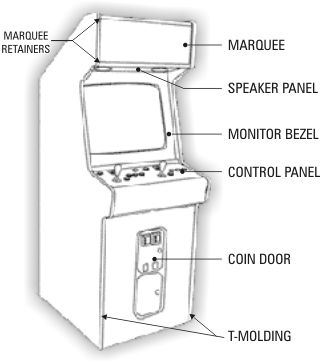Difference between revisions of "Arcade Cabinet"
m (→See also) |
(Expanded the article (someone please check/proofread)) |
||
| Line 1: | Line 1: | ||
| + | ==Types of cabinets== | ||
| + | Cabinets can be divided in few few basic categories: | ||
| + | ===Upright/Standard cabinet=== | ||
| + | The standard upright cabinet is the most common cabinet. The player stands behind the cabined or seated on a barstool. Multiple cabinets of this type can be lined up against a wall to save space and still be playable. | ||
| + | ===Cocktail cabinet=== | ||
| + | The cocktail cabinet is basically a table with a screen in it. This cabinet is usually fitted with controls for two or more players, each sitting at one side of the table. Some games are designed with this kind of play in mind (players sitting opposite of eachother) while other games 'flip' the screen to alernate between players. | ||
| + | ===Driving/Sitdown cabinet=== | ||
| + | The driving cabinet mimics the driver's seat (or pilot's seat depending on the game) with a steeringwheel of flight yoke as main controls. Usually these cabinets feature stick shift and throttle and brake pedals. Elaborate sitdown cabinets are powered by hydraulics to mimic the movement as seen on screen. One of the most elaborate sitdown cabinets is Sega's [http://www.system16.com/hardware.php?id=844 R-360] cabinet. | ||
| + | ===Bartop arcades=== | ||
| + | A bartop arcade is a small version of an arcade game cabinet to be placed on a table (or bar). | ||
| + | ===Specialised cabinets=== | ||
| + | A category of cabinets that are specialised for the game it plays. This includes the ''Dance Dance Revolution'' cabinets that feature dance pads as controls. | ||
| + | ==Anatomy of a cabinet== | ||
[[image:cabinet1.jpg|left]] | [[image:cabinet1.jpg|left]] | ||
Arcade cabinets vary in size and complexity, but they are generally comprised of the same base features as shown on the left. | Arcade cabinets vary in size and complexity, but they are generally comprised of the same base features as shown on the left. | ||
| − | |||
==See also== | ==See also== | ||
Various parts of the arcade cabinet are explained in more detail: | Various parts of the arcade cabinet are explained in more detail: | ||
Revision as of 10:04, 14 March 2006
Contents
Types of cabinets
Cabinets can be divided in few few basic categories:
Upright/Standard cabinet
The standard upright cabinet is the most common cabinet. The player stands behind the cabined or seated on a barstool. Multiple cabinets of this type can be lined up against a wall to save space and still be playable.
Cocktail cabinet
The cocktail cabinet is basically a table with a screen in it. This cabinet is usually fitted with controls for two or more players, each sitting at one side of the table. Some games are designed with this kind of play in mind (players sitting opposite of eachother) while other games 'flip' the screen to alernate between players.
Driving/Sitdown cabinet
The driving cabinet mimics the driver's seat (or pilot's seat depending on the game) with a steeringwheel of flight yoke as main controls. Usually these cabinets feature stick shift and throttle and brake pedals. Elaborate sitdown cabinets are powered by hydraulics to mimic the movement as seen on screen. One of the most elaborate sitdown cabinets is Sega's R-360 cabinet.
Bartop arcades
A bartop arcade is a small version of an arcade game cabinet to be placed on a table (or bar).
Specialised cabinets
A category of cabinets that are specialised for the game it plays. This includes the Dance Dance Revolution cabinets that feature dance pads as controls.
Anatomy of a cabinet
Arcade cabinets vary in size and complexity, but they are generally comprised of the same base features as shown on the left.
See also
Various parts of the arcade cabinet are explained in more detail:
